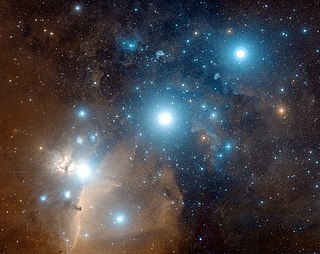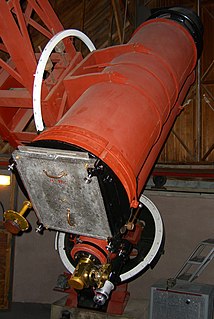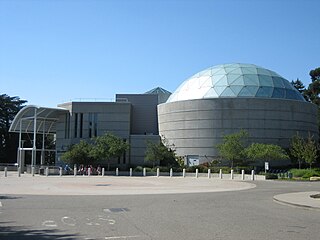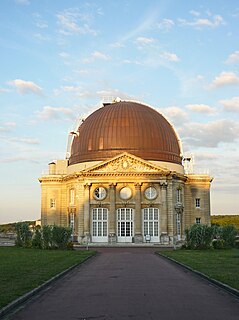
Astrophotography, also known as astronomical imaging, is photography or imaging of astronomical objects, celestial events, and areas of the night sky. The first photograph of an astronomical object was taken in 1840, but it was not until the late 19th century that advances in technology allowed for detailed stellar photography. Besides being able to record the details of extended objects such as the Moon, Sun, and planets, astrophotography has the ability to image objects invisible to the human eye such as dim stars, nebulae, and galaxies. This is done by long time exposure since both film and digital cameras can accumulate and sum light photons over these long periods of time.

Yerkes Observatory is an astronomical observatory located in Williams Bay, Wisconsin, U.S.A. It was operated by the University of Chicago Department of Astronomy and Astrophysics from its founding in 1897 to 2020. Ownership was transferred to the non-profit Yerkes Future Foundation (YFF) in May 2020.

The history of the telescope can be traced to before the invention of the earliest known telescope, which appeared in 1608 in the Netherlands, when a patent was submitted by Hans Lippershey, an eyeglass maker. Although Lippershey did not receive his patent, news of the invention soon spread across Europe. The design of these early refracting telescopes consisted of a convex objective lens and a concave eyepiece. Galileo improved on this design the following year and applied it to astronomy. In 1611, Johannes Kepler described how a far more useful telescope could be made with a convex objective lens and a convex eyepiece lens. By 1655, astronomers such as Christiaan Huygens were building powerful but unwieldy Keplerian telescopes with compound eyepieces.

A refracting telescope is a type of optical telescope that uses a lens as its objective to form an image. The refracting telescope design was originally used in spy glasses and astronomical telescopes but is also used for long-focus camera lenses. Although large refracting telescopes were very popular in the second half of the 19th century, for most research purposes, the refracting telescope has been superseded by the reflecting telescope, which allows larger apertures. A refractor's magnification is calculated by dividing the focal length of the objective lens by that of the eyepiece.

Space Place at Carter Observatory is housed in a historic astronomical observatory located at the top of the Wellington Botanic Garden in Wellington, New Zealand.

An astrograph is a telescope designed for the sole purpose of astrophotography. Astrographs are mostly used in wide-field astronomical surveys of the sky and for detection of objects such as asteroids, meteors, and comets.

Chamberlin Observatory is an astronomical observatory owned and operated by the University of Denver. It is located in Denver, Colorado (US) in Observatory Park. It is named for Humphrey B. Chamberlin, a Denver real estate magnate who pledged $50,000 in 1888 to build and equip the facility.

The Royal Observatory of Belgium, has been situated in the Uccle municipality of Brussels (Belgium) since 1890. It was first established in Saint-Josse-ten-Noode in 1826 by William I under the impulse of Adolphe Quetelet. It was home to a 100 cm (39 in) diameter aperture Zeiss reflector in the first half of the 20th century, one of the largest telescopes in the world at the time. It owns a variety of other astronomical instruments, such as astrographs, as well as a range of seismograph equipment.

Chabot Space and Science Center, located in Oakland, California, is a center for science learning featuring interactive exhibits, planetariums, a large screen theater, hands-on activities and three powerful telescopes.

A telescope is an optical instrument using lenses, curved mirrors, or a combination of both to observe distant objects, or various devices used to observe distant objects by their emission, absorption, or reflection of electromagnetic radiation. The first known practical telescopes were refracting telescopes invented in the Netherlands at the beginning of the 17th century, by using glass lenses. They were used for both terrestrial applications and astronomy.

Fuertes Observatory is an astronomical observatory located on the North Campus of Cornell University in Ithaca, New York. The observatory was designed by L.P. Burnham, Cornell Professor of Architecture and completed in fall of 1917. It was originally used by the Civil Engineering Department as an instructional field office for navigation and surveying. Today, the observatory is primarily used for public outreach, welcoming over two thousand visitors per year with open houses on clear Friday nights.

The Dearborn Observatory is an astronomical observatory located on the Evanston campus of Northwestern University. The observatory was originally constructed in 1888, through an agreement between the university and the Chicago Astronomical Society. In the summer of 1939, Dearborn Observatory had to be moved to make way for the construction of the Technological Institute.

An aerial telescope is a type of very long focal length refracting telescope, built in the second half of the 17th century, that did not use a tube. Instead, the objective was mounted on a pole, tree, tower, building or other structure on a swivel ball-joint. The observer stood on the ground and held the eyepiece, which was connected to the objective by a string or connecting rod. By holding the string tight and maneuvering the eyepiece, the observer could aim the telescope at objects in the sky. The idea for this type of telescope may have originated in the late 17th century with the Dutch mathematician, astronomer and physicist Christiaan Huygens and his brother Constantijn Huygens, Jr., though it is not clear if they actually invented it.

Great refractor refers to a large telescope with a lens, usually the largest refractor at an observatory with an equatorial mount. The preeminence and success of this style in observational astronomy defines an era in modern telescopy in the 19th and early 20th century. Great refractors were large refracting telescopes using achromatic lenses. They were often the largest in the world, or largest in a region. Despite typical designs having smaller apertures than reflectors, great refractors offered a number of advantages and were popular for astronomy. It was also popular to exhibit large refractors at international exhibits, and examples of this include the Trophy Telescope at the 1851 Great Exhibition, and the Yerkes Great Refractor at the 1893 World's Fair in Chicago.

The Linden Observatory Complex is a heritage-listed former observatory and manufacture of optical precision implements and now residence, museum, observatory, education facility and meeting venue located at 91 – 111 Glossop Road, Linden, City of Blue Mountains, New South Wales, Australia. It was designed and built by Ken Beames from 1938 to 1948. It is also known as K Beames Engineering Co. The property is owned by the Linden Observatory Trust. It was added to the New South Wales State Heritage Register on 5 March 2010.

The Greenwich 28-inch refractor is a telescope at the Royal Observatory, Greenwich, where it was first installed in 1893. It is a 28-inch ( 71 cm) aperture objective lens telescope, otherwise known as a refractor, and was made by the telescope maker Sir Howard Grubb. The achromatic lens was made Grubb from Chance Brothers glass. The mounting is older however and dates to the 1850s, having been designed by Royal Observatory director George Airy and the firm Ransomes and Simms. The telescope is noted for its spherical dome which extends beyond the tower, nicknamed the "onion" dome. Another name for this telescope is "The Great Equatorial" which it shares with the building, which housed an older but smaller telescope previously.

Potsdam Great Refractor is an historic astronomical telescope in an observatory in Potsdam, Germany.

Meudon Great Refractor is a double telescope with lenses, in Meudon, France. It is a twin refracting telescope built in 1891, with one visual and one photographic, on a single square-tube together on an equatorial mount, inside a dome. The Refractor was built for the Meudon Observatory, and is the largest double doublet refracting telescope in Europe, but about the same size as several telescopes in this period, when this style of telescope was popular. Other large telescopes of a similar type include the James Lick telescope (91.4), Potsdam Great Refractor (80+50 cm), and the Greenwich 28 inch refractor (71.1 cm).

Arago telescope is a 38 cm aperture refracting telescope at Paris Observatory, installed in 1857. Francois Arago ordered this telescope from the telescope making firm Lebreours in 1839, and after a protracted development was completed by 1855. The name Lunette Arago is a modern name for the telescope, and other large refractor of Paris observatory, is the one at Meudon. It has gone by a variety of names having to do with various aspects of the telescope, such as its aperture, or location on the East tower of the Paris observatory, or its equatorial mount made by Brunner. In one journal report it was called the 'east equatorial' for example, in another instance '38 cm refractor'. In French language it has been called the La lunette équatoriale de 38 cm de l'Observatoire de Paris.



















